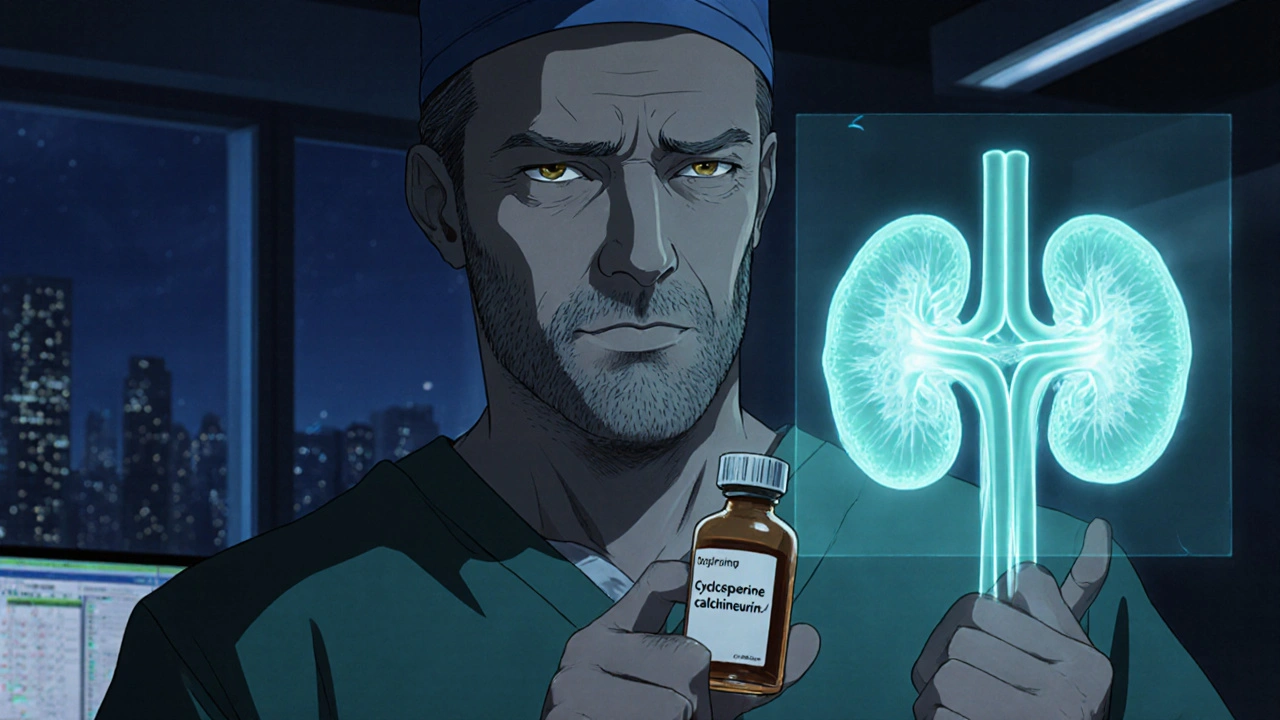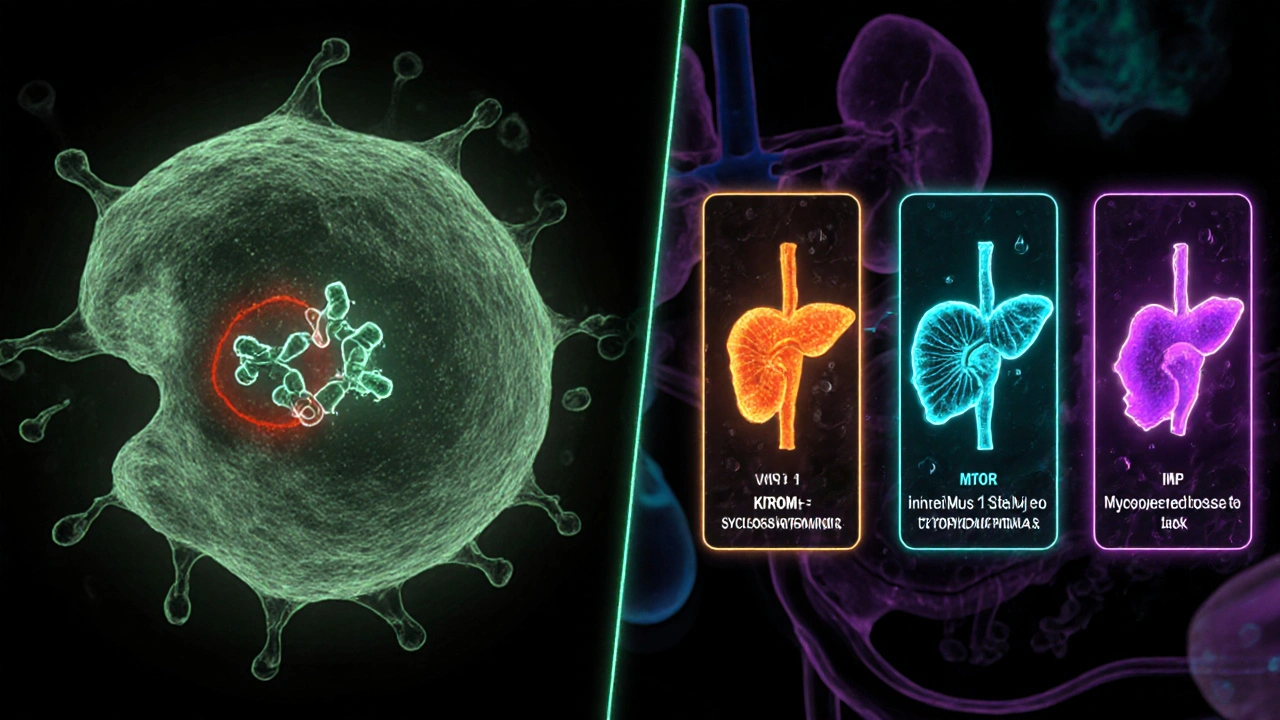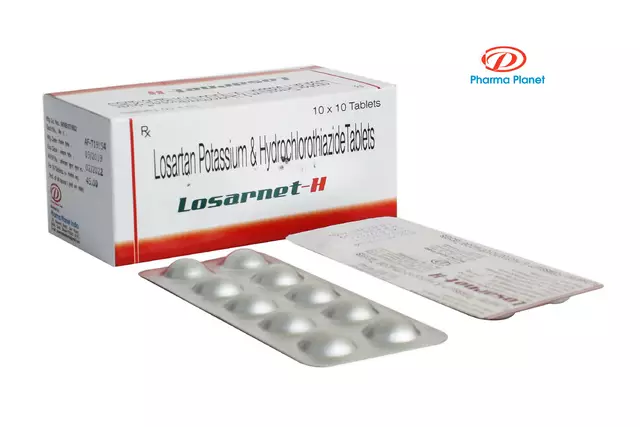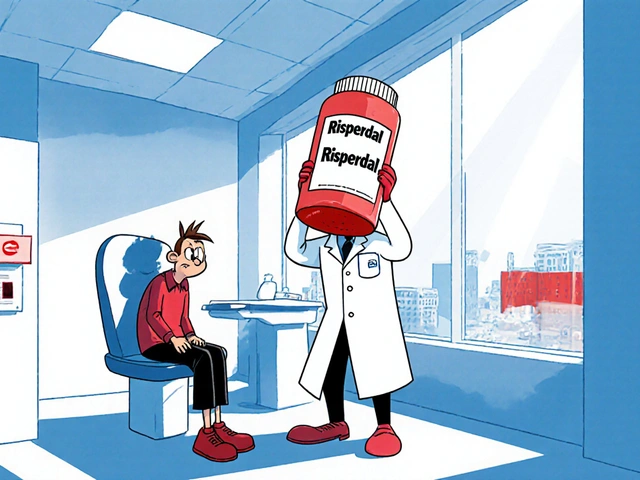
Immunosuppressant Comparison Tool
Compare Immunosuppressants
Select a drug to compare with cyclosporine and choose which factors to evaluate based on your patient's needs.
Cyclosporine vs.
| Category | Cyclosporine | |
|---|---|---|
| Side Effects | ||
| Cost (monthly) | ||
| Mechanism of Action | ||
| Renal Safety | ||
| Diabetes Risk | ||
| Key Considerations |
Quick Summary
- Cyclosporine is a calcineurin inhibitor used mainly for organ‑transplant rejection prevention.
- Common alternatives include Tacrolimus, Sirolimus, Mycophenolate mofetil, Azathioprine and low‑dose Prednisone.
- Mechanisms differ: calcineurin inhibition vs mTOR inhibition vs antimetabolite action.
- Side‑effect profiles vary - watch for nephrotoxicity with calcineurin inhibitors and metabolic issues with mTOR blockers.
- Cost, dosing convenience and patient comorbidities often decide which drug fits best.
When doctors need to keep an immune system in check, especially after a solid‑organ transplant, they reach for a class of drugs called immunosuppressants. Cyclosporine is a calcineurin inhibitor that has been a cornerstone of transplant medicine since its FDA approval in 1983. It works by blocking a key enzyme needed for T‑cell activation, effectively dialing down the body’s attack on a new organ.
How Cyclosporine Works
Cyclosporine binds to the intracellular protein cyclophilin, forming a complex that inhibits calcineurin. Without calcineurin, the transcription factor NFAT stays inactive, and cytokine production (especially IL‑2) drops dramatically. The result is a reduced proliferative response of T‑lymphocytes, which are the main drivers of acute graft rejection.
Typical Uses and Dosing
Beyond kidney, liver, heart and lung transplants, Cyclosporine is prescribed for severe psoriasis and certain autoimmune disorders. Dosing is weight‑based: 3-5 mg/kg per day divided into two doses for transplants, with target trough levels of 100-400 ng/mL depending on the organ and time post‑surgery. Oral bioavailability is variable (20‑50 %), so therapeutic drug monitoring is essential.
Pros and Cons of Cyclosporine
- Pros: Long track record, well‑studied dosing algorithms, effective at preventing acute rejection.
- Cons: Nephrotoxicity, hypertension, gum hyperplasia, and drug‑drug interactions (especially with CYP3A4 inhibitors).

Major Alternatives
When Cyclosporine’s side‑effects become problematic or when clinicians want a more convenient regimen, several alternatives are on the table.
Tacrolimus (FK‑506) is another calcineurin inhibitor, but it binds to FKBP‑12 instead of cyclophilin. It’s often favored for its slightly lower nephrotoxic profile and a reduced incidence of gum overgrowth.
Sirolimus (rapamycin) belongs to the mTOR inhibitor class. Rather than blocking calcineurin, it halts the downstream signaling that drives cell growth, making it useful for patients who need steroid‑sparing regimens.
Mycophenolate mofetil (MMF) is an antimetabolite that interferes with guanine nucleotide synthesis, curbing proliferation of both T and B cells. It’s commonly combined with low‑dose calcineurin inhibitors.
Azathioprine works by inserting fraudulent nucleotides into DNA, broadly suppressing lymphocyte activity. It’s older and cheaper but can cause bone‑marrow suppression.
Prednisone is a corticosteroid that dampens inflammation and immune activation via glucocorticoid receptors. While not a direct alternative for long‑term maintenance, low‑dose prednisone is often added to reduce the required dose of other drugs.
Side‑Effect Profiles at a Glance
| Drug | Class | Primary Mechanism | Typical Uses | Common Side Effects | Typical Cost (USD/month) |
|---|---|---|---|---|---|
| Cyclosporine | Calcineurin inhibitor | Blocks calcineurin → ↓ IL‑2 | Kidney, liver, heart, lung transplants; psoriasis | Nephrotoxicity, hypertension, gum hyperplasia | ≈$200-$400 |
| Tacrolimus | Calcineurin inhibitor | Blocks calcineurin via FKBP‑12 | Kidney & liver transplants, atopic dermatitis | Nephrotoxicity, diabetes, neurotoxicity | ≈$250-$500 |
| Sirolimus | mTOR inhibitor | Inhibits mTOR → ↓ cell growth | Kidney transplants, stent coatings | Hyperlipidemia, delayed wound healing, anemia | ≈$300-$600 |
| Mycophenolate mofetil | Antimetabolite | Inhibits IMP dehydrogenase → ↓ guanosine | Kidney, heart, liver transplants; lupus | GI upset, leukopenia, infection risk | ≈$150-$300 |
| Azathioprine | Antimetabolite | Incorporates into DNA → faulty replication | Transplant maintenance, IBD, rheumatoid arthritis | Bone‑marrow suppression, liver toxicity | ≈$30-$80 |
| Prednisone | Corticosteroid | Glucocorticoid receptor agonist → broad anti‑inflammation | Bridge therapy, acute rejection episodes | Weight gain, osteoporosis, glucose intolerance | ≈$10-$20 |
Decision Criteria: When to Pick Cyclosporine vs an Alternative
- Renal function: If baseline creatinine is already high, Tacrolimus may offer a slightly milder nephrotoxic profile, but both share risk.
- Diabetes risk: Sirolimus and Tacrolimus can worsen glucose control; choose Mycophenolate or Azathioprine for diabetic patients.
- Drug‑interaction burden: Cyclosporine and Tacrolimus are heavy CYP3A4 substrates. Patients on azole antifungals or certain antivirals may need dose adjustments.
- Adherence considerations: Once‑daily formulations like extended‑release Tacrolimus improve compliance compared to twice‑daily Cyclosporine.
- Cost constraints: Azathioprine and low‑dose Prednisone are far cheaper, making them viable in resource‑limited settings.

Practical Tips for Managing Cyclosporine Therapy
- Monitor trough levels weekly for the first month, then every 1-2 months once stable.
- Check serum creatinine and blood pressure at each visit; adjust dose if either trends upward.
- Advise patients to avoid grapefruit juice and over‑the‑counter meds like erythromycin without consulting a pharmacist.
- Consider prophylactic antivirals (e.g., valganciclovir) if the patient’s CMV serostatus warrants it.
- Educate about gum overgrowth; regular dental hygiene can mitigate severity.
Future Trends in Immunosuppression
Research is moving toward targeted biologics (e.g., belatacept) and cellular therapies that could eventually replace broad‑spectrum agents like Cyclosporine. Until those become mainstream, clinicians must balance efficacy, safety, and cost using the toolbox of existing drugs.
Frequently Asked Questions
What is the main difference between Cyclosporine and Tacrolimus?
Both block calcineurin, but Cyclosporine binds cyclophilin while Tacrolimus binds FKBP‑12. Tacrolimus often has a lower incidence of gum hyperplasia and may be slightly less nephrotoxic, though both require careful therapeutic monitoring.
Can I switch from Cyclosporine to Mycophenolate mofetil?
Yes, many transplant centers use a tacrolimus‑plus‑mycophenolate regimen after the early post‑operative period. The switch should be done gradually, under close lab monitoring, to avoid sudden loss of immunosuppression.
Why does Cyclosporine cause gum overgrowth?
The drug stimulates fibroblast activity in the gingival tissue, leading to hypertrophy. Good oral hygiene and regular dental check‑ups can keep the growth manageable.
Is Sirolimus a good alternative for patients with kidney dysfunction?
Sirolimus is less nephrotoxic than calcineurin inhibitors, making it attractive for patients with marginal renal function. However, it can delay wound healing, so timing around surgery matters.
How often should I get blood tests while on Cyclosporine?
Initially weekly for the first 4-6 weeks, then every 1-2 months once stable. Always include trough level, serum creatinine, and blood pressure readings.





Karla Johnson
October 18, 2025 AT 15:05When you examine the therapeutic landscape of immunosuppression, the first point of contrast lies in the mechanistic nuance between calcineurin inhibition and mTOR blockade, and this distinction reverberates through clinical outcomes. Cyclosporine, binding to cyclophilin, effectively curtails IL‑2 transcription, a fact that underpins its long‑standing success in preventing acute graft rejection. However, the nephrotoxic shadow it casts cannot be ignored, especially in patients whose baseline creatinine is already elevated. Tacrolimus, while sharing the calcineurin target, partners with FKBP‑12 and generally shows a milder impact on renal function, though it introduces its own risk of new‑onset diabetes. Sirolimus, by contrast, sidesteps calcineurin entirely, offering a kidney‑friendly alternative at the expense of delayed wound healing and dyslipidemia. Mycophenolate mofetil operates upstream of nucleotide synthesis, thereby dampening both T‑ and B‑cell proliferation without the classic nephrotoxic concerns, but it brings gastrointestinal upset and leukopenia into the equation. Azathioprine, the budget‑friendly veteran, can be a viable option where cost constraints dominate, yet its bone‑marrow toxicity requires vigilant monitoring. Low‑dose prednisone remains a useful adjunct, tempering inflammation while allowing lower doses of the more toxic agents. The choice among these agents must also factor in drug‑drug interaction burdens; both cyclosporine and tacrolimus are heavy CYP3A4 substrates, so concurrent azole antifungals or certain antivirals can precipitate toxicity. Adherence considerations further sway the decision, as extended‑release tacrolimus formulations simplify dosing schedules compared with the twice‑daily regimen of cyclosporine. In resource‑limited settings, the economic advantage of azathioprine and prednisone cannot be overstated. Monitoring protocols differ as well: cyclosporine demands weekly trough assessments initially, while mycophenolate levels are less routinely checked. Patient education on oral hygiene mitigates gum hyperplasia, a hallmark adverse effect of cyclosporine that can be socially embarrassing. Ultimately, the clinician must balance efficacy, safety, cost, and patient preference, tailoring the regimen to the individual’s comorbidities and lifestyle. Emerging biologics such as belatacept promise a future where broad‑spectrum agents become obsolete, but until then, the art of immunosuppression remains a careful orchestration of existing tools.